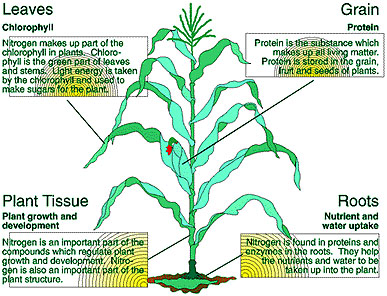Nitrogen in the plant is a very important subject. There is more nitrogen in plants than any other element, with the exception of carbon, hydrogen and oxygen. Nitrogen plays an important part in many essential functions and compounds necessary for life.
Nitrogen may be found in various parts of the plant in different forms. There is nitrogen in the leaves, grain, plant tissue and roots of plants. Nitrogen may function as part of the plant structure or be involved in the life processes.
Leaves — chlorophyll
Nitrogen makes up part of the chlorophyll in plants. Chlorophyll is the green part of leaves and stems. Light energy is taken by the chlorophyll and used to make sugars for the plant.
Plant tissue — plant growth and development
Nitrogen is an important part of the compounds that regulate plant growth and development. Nitrogen is also an important part of the plant structure.
Grain — protein
Protein is the substance that makes up all living matter. Protein is stored in the grain, fruit and seeds of plants.
Roots — nutrient and water uptake
In the roots, nitrogen is found in proteins and enzymes. They help the nutrients and water be taken up into the plant.
 Figure 1
Figure 1
Nitrogen in the plant.
This publication was written by Karen DeFelice, former associate extension agronomist; Nyle Wollenhaupt, former state extension agronomist; and Daryl Buchholz, state extension agronomist. This material is based upon work supported by the United States Department of Agriculture, Extension Service, under special project number 89-EWQI-1-9203.